Ford F-150 Vs Ram 1500: Which Half-Ton Truck is Right for You?
The half-ton truck segment is the most popular in North America, with these large trucks serving as America’s bestselling vehicles for more than 30 straight years.
While it is one of the smallest segments in terms of the number of competitors, full-sized trucks account for millions of vehicles per year, making them a key concern for the American automakers.
The Ford F-Series has been the bestselling truck in the United States for decades and the F-150 is the bestselling model within the F-Series lineup. On the other hand, the Ram Trucks brand was introduced in 2009 as an off-shoot of the Dodge brand and in that time, the Ram 1500 has become the second-best-selling truck in the USA. While Ford has always been a leader in innovation and continues to be such, the Ram 1500 has a long list of features that it introduced to the segment.
Get a Quote on a New Ford F-150 or Ram 1500The Ford F-150 and the Ram 1500 are both leaders in truck technology in terms of interior and drivetrain features. They both have plush, luxury-level models, they both have a small diesel engine, they both have a hybrid model and they both have a high performance model. So which one is right for you? Below, we take a close look at both of these trucks, highlighting the advantages for each.
Cabin Space
The biggest difference between the Ford F-150 and Ram 1500 lineups right now is that Ram doesn’t offer a two-door, regular cab configuration. The F-150 is offered with a Regular Cab, a Super Cab or a Super Crew layout, with those “super” packages including four doors. The Ram 1500 is available in Quad Cab or Crew Cab configuration, both of which have four doors.
F-150: The Ford F-150 has three very different cab sizes, but no matter which you order, you get the same amount of space for the driver and front passenger. The Regular Cab, Super Cab and Super Crew F-150 all offer 40.8 inches (1,036 mm) of head room, 43.9 inches (1,115 mm) of leg room, 66.7 inches (1,694 mm) of shoulder room and 62.5 inches (1,588 mm) of hip room. In Super Cab models, which is the smaller of the two four-door F-150 layouts, the rear seats offer 40.3 inches (1,024 mm) of head room, 33.5 inches (851 mm) of leg room, 66.1 inches (1,679 mm) of shoulder room and 62.6 inches (1,590 mm) of hip room. Super Crew models offer similar head, shoulder and hip room, but with 43.6 inches (1,107 mm) of rear leg room, the Super Crew is 10 inches roomier than the Super Cab for passengers with long legs.
Ram 1500: The Ram 1500 has two cab sizes, Quad Cab and Crew Cab, both of which are four-door models. In both the Quad Cab and Crew Cab models, buyers get the same front seating space, including 40.9 inches (1,039 mm) of head- and leg room, 66.0 inches (1,676 mm) of shoulder room and 63.4 inches (1,610 mm) of hip room. In the rear seating area of the Quad Cab, the Ram 1500 offers 39.2 inches (996 mm) of head room, 35.6 inches (904 mm) of leg room, 65.7 inches (1,669 mm) of shoulder room and 63.4 inches (1,610 mm) of hip room. The larger Crew Cab offers a bit more head room with 39.8 inches (1,011 mm) and a ton more leg room with 45.2 inches (1,148 mm) while sharing the shoulder and hip room dimensions with the Quad Cab.
SEE ALSO: 2021 Ford F-150 PowerBoost Hybrid Review: This Isn’t Your Father’s HybridBottom Line: If you don’t really need much interior space, the fact that Ford offers a Regular Cab makes the F-150 an easy choice. If you want the most space for the driver and front passenger, the F-150 has the edge there as well, while the Ram 1500 has the advantage in rear leg room, making it the better pick for a truck owner who hauls taller passengers.
Cargo and Towing
The Ford F-150 and Ram 1500 are two of the most capable trucks in the world, routinely battling back and forth to be the king of the class in terms of towing and payload. Towing and payload numbers vary based on engine, body size and drivetrain configurations, meaning that there are many different ratings for the F-150 and the Ram 1500. With that in mind, we focused on the payload and towing leader from each model, along with a look at the towing and payload capabilities of the hybrid and diesel models.
F-150: The Ford F-150 can tow up to 14,000 pounds with the 3.5-liter EcoBoost V6, making it the overall towing leader in the half-ton segment. When it comes to payload capacity, the 5.0-liter V8 is Ford’s go-to, carrying up to 3,325 pounds. At the same time, the EcoBoost can haul 3,250 pounds and the V8 can tow 13,000 pounds, so picking one over the other doesn’t require much compromise in either category. The new Ford PowerBoost hybrid F-150 can tow 12,700 pounds and carry 2,120 pounds while the 3.0-liter PowerStroke diesel can tow 12,100 pounds and haul 1,840 pounds.
The upcoming all-electric F-150 Lightning gives up little outright capability over its gas-powered siblings. In Standard-Range form it will carry up to 2,000 pounds and tow 7,700. The Extended-Range has a smaller payload at 1,800 pounds, but can tow an even 10,000.
Ram 1500: The top towing engine for the Ram 1500 can pull up to 12,560 pounds with the 5.7-liter Hemi V8 eTorque hybrid drive while the non-hybrid Hemi can tow 11,610 pounds and haul 1,940 pounds. The payload leader from Ram is actually its base 3.6-liter V6, which can haul up to 2,320 pounds. The hybrid Hemi will also haul 1,850 pounds while the 3.0-liter EcoDiesel V6 will tow 12,560 pounds and haul 2,060 pounds. Finally, the supercharger Ram TRX isn’t really designed to tow or haul, but it will pull a trailer weighing up to 8,100 pounds and carry 1,850 pounds worth of cargo.
SEE ALSO: 2020 Ram 1500 Big Horn Review: Putting the ‘Light’ in Light-DutyBottom Line: The F-150 has a higher towing capacity and a higher payload capacity, while offering better capabilities in hybrid form as well, making the Ford the better choice for any buyer who is focused on the highest possible towing and hauling numbers. The two areas where the Ram 1500 has the advantage here are with the diesel engine and the TRX. Someone who wants the fuel economy figures of the diesel will get better towing and hauling numbers with the Ram 1500 and for someone who wants a 700+ horsepower half-ton to tow and haul, the Ram is the only choice.
Technology and Features
When the Ford F-150 became the best-selling vehicle in North America back in the 1970s, there was no real technology inside and very few premium features. In most cases, the Ford and then-Dodge trucks 40 years ago had all-metal interiors, sometimes lined with vinyl-wrapped cardboard panels with more vinyl on the seats. Some trucks only had one speaker to listen to an AM radio, but really plush trucks back then had an AM/FM radio with a tape deck and five or six speakers. They had heat, but few had air conditioning, so if you were really lucky in the 1980s, your truck might have had a cassette player, air conditioning and power windows, but those trucks were few and far between. However, as more Americans made large trucks their daily drivers, we have seen a shift towards the luxurious end of the spectrum across all trucks. In fact, today’s half-ton pickups from Ford and Ram have interior features that rival the likes of the European luxury brands, although the base trucks avoid cost-increasing niceties for those who want a traditional work truck.
F-150: The Ford F-150 in XL and XLT trim comes with a cloth 40/20/40 split front bench seat in all three cab configurations, and in four-door models a 60/40 split rear bench is standard. Front bucket seats are optional with both of those trim levels. The Lariat models are the first to add leather, with a 40/20/40 split bench featuring 10-way power adjustability for the driver’s seat and power adjustability for the front passenger’s outboard seat. Again, front bucket seats are available, wrapped in leather and a matching leather steering wheel is standard with the F-150 Lariat as well. The King Ranch has unique leather upholstery on standard front bucket seats that are both heated and cooled, with the leather-wrapped split rear bench having heated outboard seats as well. Platinum and Limited models come with unique multi-contour leather seats with the Active Motion system, power adjustability, heated and cooled front surfaces and heated rear outboard surfaces.
The F-150 XL comes with some very basic amenities, including manual door locks, manual air conditioning and a manual tilt/telescoping steering wheel. This base F-150 does include some features once unheard of in a lower-priced pickup, such as a 4.0-inch productivity screen in the gauge cluster, an 8.0-inch infotainment screen with the SYNC 4 system, Ford Co-Pilot360 Technology including Pre-Collision Assist with Automatic Emergency Braking and FordPass Connect with WiFi. The XLT trim level comes with all of those items and adds cruise control, a Lane-Keeping System and a Reverse Sensing System. The Lariat trim adds Intelligent Access with Push-Button Start, Dual-Zone Electronic Automatic Temperature Control, a 12.0-inch productivity screen in the gauge cluster, SYNC 4 with Enhanced Voice Recognition and a 12.0-inch infotainment screen in the center stack. The King Ranch and Platinum models add Intelligent Adaptive Cruise Control, Adaptive Steering, an 8.0-speaker B&O sound system and connected navigation. Finally, the range-topping Limited models feature the 360-Degree Camera Package, Active Park Assist 2.0, Pro Trailer Backup Assist, Trailer Reverse Guidance, the Forward Sensing System and the B&O 18-speaker sound system.
Ram 1500: The Ram 1500 Tradesman comes with a 40/20/40 split front bench seat and a folding rear seat, both of which are covered in cloth. The Big Horn trim level comes with the same front seats, but it adds a 60/40 split rear bench seat and there are also optional front bucket seats with power adjustability. Laramie models have the split front bench and 60/40 rear bench, but heated and cooled leather seats are standard, with eight-way power driver and passenger adjustability. The Ram Rebel is the first package in the lineup to come with bucket seats, with unique cloth patterns and vinyl trim, but leather is optional. The Limited Longhorn trim level adds leather-wrapped front bucket seats with eight-way power adjustability, heated and cooled surfaces up front while the rear seat reclines and offers heated outboard positions. The top-of-the-line Limited models feature premium leather seats with power controls and both heated and cooled surfaces. As for the 702-horsepower Ram 1500 TRX, that package comes with unique cloth bucket seats with eight-way power control, but buyers can opt up to premium leather.
SEE ALSO: Ford F-150 vs Ranger: Which Truck is Right for You?In terms of technology, the Ram 1500 Tradesman comes with a 5.0-inch touchscreen running the Uconnect 3 operating system, six speakers, manual air conditioning, power door locks, power windows, a black-and-white 3.5-inch driver information screen, push-button start, Bluetooth integration and a collection of USB and 115-volt power points. The Big Horn trim level includes all of those items and adds steering wheel audio controls on a leather-wrapped steering wheel. The Rebel builds on the Big Horn, adding an auto-dimming rear view mirror and a 7.0-inch color information screen in the gauge cluster. The Laramie trim level also builds on the Big Horn package, adding an 8.4-inch touchscreen with the Uconnect 4 operating system, Apple CarPlay, Android Auto, a nine-speaker sound system, dual-zone automatic climate control, a rear window defroster, auto-dimming rear view mirror, the 7.0-inch color driver information screen, a heated steering wheel, power adjustable pedals, remote start, a security alarm and remote keyless entry.
Limited Longhorn builds on the Laramie trim level, adding navigation, 4G LTE WiFi Hot Spot functionality, 5-Year SiriusXM Traffic Service, 5-Year SiriusXM Travel Link Service, HD Radio, SiriusXM Guardian Connected Services, SiriusXM Traffic Plus, SiriusXM Travel Link, a wood and leather-wrapped steering wheel and a remote tailgate release. On top of all of that, the Limited trim level adds the 12.0-inch Uconnect screen as standard, but that premium information system is optional on the Laramie and Limited Longhorn models as well. The high performance TRX builds on the Big Horn package, adding the 12.0-inch touchscreen, the WiFi system, the SiriusXM traffic and guardian services including SiriousXM 360L, HD Radio, a leather flat-bottom steering wheel and the Performance Pages system. Finally, Ram offers a handful of ultra-premium features that are not standard on any models, but they are available on the Longhorn, Limited and TRX models. This includes the heads-up display, cooled rear seating surfaces, a 19-speaker Harman Kardon sound system, the digital rear view mirror system, Trailer Reverse Steering Control, the Trailer Tire Pressure Monitoring System, Adaptive Cruise Control with Stop and Go, the Surround-View Camera System and the Dual-Pane Panoramic Sunroof.
Bottom Line: The interior offerings of the Ford F-150 and Ram 1500 are very similar across the trim lines, but if you want the most-premium experience, the loaded-up half-ton Ram trucks have the clear advantage. Ford simply cannot rival Ram’s combination of the 12.0-inch touchscreen with the award winning Uconnect system, the 19-speaker HK sound system, the heads-up display and the premium leather seating surfaces.
Powertrain
The Ford F-150 and Ram 1500 have relatively similar engine option lists, starting with a naturally aspirated V6 followed by a naturally aspirated V8, a hybrid option and a diesel option. The key differences come in the fact that Ford also has the 2.7-liter and 3.5-liter turbocharged EcoBoost V6 engines and Ram has the 6.2-liter, 702-horsepower supercharged V8.
Starting in early 2022, Ford will also begin offering the F-150 Lightning, an all-electric model. You can find all the details on it here. So far, Ram has no equivalent.
F-150: The base level engine for the Ford F-150 is a naturally aspirated 3.3-liter V6 which offers 290 horsepower and 265 lb-ft of torque. Next we have the turbocharged 2.7-liter EcoBoost with 325 horsepower and 400 lb-ft of torque followed by the 3.5-liter EcoBoost with 400 horsepower and 500 lb-ft of torque. The 5.0-liter V8 is next with 400 horsepower and 410 lb-ft of torque and the most powerful engine in the current F-150 lineup is the 3.5-liter PowerBoost V6 with 430 horsepower and 570 lb-ft of torque. There will also be a high performance version of the 3.5-liter EcoBoost later this year in the Raptor, but there are no concrete performance numbers thus far. The 2020 Raptor offers 450 horsepower and 510 lb-ft of torque, so the 2021 model year version will offer at least that much power. Finally, the 3.0-liter PowerStroke diesel V6 offers 250 horsepower and 440 lb-ft of torque.
A 10-speed automatic transmission is standard in all F-150 engines, as is rear-wheel-drive, with the exception of the 3.0-liter Powerstroke diesel and the Raptor EcoBoost. Those engines come standard with four-wheel-drive.
Ram 1500: The base engine for the Ram 1500 is the naturally aspirated 3.6-liter Pentastar V6 with standard eTorque hybridization, delivering 305 horsepower and 269 lb-ft of torque. Next, the 5.7-liter Hemi V8 is available with or without the eTorque hybrid assist system, but both variations of this Hemi offer 395 horsepower and 410 lb-ft of torque. The big story for the Ram 1500 is the TRX, which features the supercharged 6.2-liter Hemi from the Dodge Hellcat cars, delivering 702 horsepower and 650 lb-ft of torque. The TRX is the quickest, fastest and most powerful production truck ever. Finally, the 3.0-liter EcoDiesel V6 offers the greatest combination of power and efficiency with 260 horsepower and 480 lb-ft of torque.
An eight-speed automatic transmission is standard in all Ram 1500 models, as is rear-wheel-drive, with the exception of the TRX.
SEE ALSO: Toyota Tacoma vs Tundra: Which Truck is Right for You?Bottom Line: If you are buying a gas-powered half-ton truck based purely on power numbers, the F-150 has the advantage throughout the majority of the lineup. Ford’s base V6 and V8 offer more power than Ram’s base V6 and Hemi, Ford’s hybrid offers gobs more power than the Ram hybrid and Ram has no answer to the two Ford EcoBoost V6 engines. However, if you want monster power, there is no alternative to the Ram 1500 TRX.
Fuel Economy
Ford and Ram have both made great strides in making their popular half-ton trucks more fuel-friendly over the course of the past decade. The introduction of light weight body materials, improved aerodynamics and the modern transmissions with 8 and 10 speeds all play a big role in helping the F-150 and Ram 1500 achieve better fuel economy numbers.
F-150: The most fuel-friendly engine in the rear-drive F-150 lineup is the 2.7-liter EcoBoost, offering 20 mpg around town, 26 on the highway and 22 combined. Next is the base 3.3-liter V6 with figures of 20 city, 24 highway and 21 combined, while the 3.5-liter EcoBoost offers similar numbers with 18 city, 24 highway and 20 combined. The 5.0-liter V8 is Ford’s least efficient engine in terms of mpg, but it still offers solid rear-drive numbers of 17 in the city, 24 highway and 20 combined. The 3.5-liter PowerBoost hybrid models with rear-drive offer 25 in the city, 26 on the highway and 25 combined mpgs.
Among four-wheel-drive F-150 models, the 3.0-liter PowerStroke diesel is the non-hybrid fuel economy leader with ratings of 20 mpg around town, 27 on the highway and 23 combined. The 2.7-liter EcoBoost is next with 19 city, 24 highway and 21 combined, followed by the 3.3-liter base V6 at 19 city, 22 highway and 20 combined. Meanwhile, the 3.5-liter EcoBoost is in the same ballpark with 18 city, 23 highway and 20 combined. The 5.0-liter V8 is only a touch worse with four-wheel-drive, offering 16 city, 22 highway and 19 combined, while the four-wheel-drive F-150 PowerBoost hybrid offers 24 mpg in every driving situation.
Ram 1500: The most fuel efficient engine in the Ram 1500 lineup is the 3.0-liter EcoDiesel, which is offered with rear-drive and Ram’s HFE – High Fuel Economy – package. The 3.0-liter diesel is rated at 22 mpg in the city, 32 on the highway and 26 combined while the diesel HFE package lifts city and highway numbers by 1 unit and combined remains the same. The 3.6-liter Pentastar V6 with the standard eTorque hybrid system is rated at 20 city, 25 highway and 22 combined. The 5.7-liter Hemi V8 non-hybrid is rated at 15 city, 22 highway and 17 combined while the Hemi hybrid offers 17 city, 23 highway and 19 combined.
The most fuel-friendly four-wheel-drive Ram 1500 engine is once again the 3.0-liter EcoDiesel, offering 21 city, 29 highway and 24 combined. The 3.6-liter Pentastar with the standard eTorque hybrid system is rated at 19 city, 24 highway and 21 combined. Non-hybrid 5.7-liter Hemis with four-wheel-drive offers 15 city, 21 highway and 17 combined, while the addition of the eTorque hybrid system to the Hemi lifts numbers to 17 around town, 22 on the highway and 19 combined. Finally, the Ram 1500 TRX with 702 horsepower offers the worst fuel economy numbers in the half-ton segment, offering 10 miles-per-gallon around town, 14 on the highway and 12 combined, but TRX economy should be measured in smiles-per-gallon, not miles-per-gallon.
SEE ALSO: 2021 Ram 1500 TRX Review: First DriveBottom Line: If you want a half-ton truck that gets the highest possible miles-per-gallon rating, the Ram 1500 with the EcoDiesel is your best choice whether you are buying rear-drive of four-wheel-drive. If you want the best possible gasoline fuel economy the F-150 PowerBoost is the best direction, and if you want the best combination of power and efficiency, the F-150 with the 3.5-liter EcoBoost is the king of the hill. The Ram 1500 V8 beats the F-150 V8 thanks to the functionality of the eTorque hybrid system.
Safety
When pickup trucks began really building popularity in the United States, they were fairly barebones vehicles with few (if any) premium safety features. However, considering their size relative to other vehicles on the road and the constant push for everyone to be safer while driving, both Ford and Ram have introduced a long list of standard and available safety features on all of their trucks.
F-150: The Ford F-150 XL comes standard with a Rear View Camera with Dynamic Hitch Assist, the SOS Post-Crash Alert System, the SecuriLock Passive Anti-Theft System, wheel locks, AdvanceTrac with Roll Stability Control, Curve Control, four-wheel antilock brakes, a tire pressure monitoring system and the expected spread of safety belts, including height adjustment, pretensioners and Energy Management Retractors up front. In terms of airbags, every new F-150 comes with driver and passenger front airbags, driver and passenger seat-mounted side airbags and safety canopy side curtain airbags. When you step up to the XLT, you get everything from the XL as well as the MyKey system, Perimeter Anti-Theft Alarm, Remote Keyless Entry System and BLIS with Cross-Traffic Alert. The Lariat trim level adds the Advanced Security Pack, remote start, the SecuriCode Keyless Entry Keypad system, blind spot monitoring with cross-traffic alert, and Trailer Tow Coverage. The King Ranch and Platinum models offer the same safety items, including everything above plus Intersection Assist, and the range-topping F-150 Limited adds the Active Drive Assist Prep Kit for hands-free driving.
Ram 1500: The Ram 1500 Tradesman comes standard with a long list of safety features, beginning with electronic roll mitigation, electronic stability control, hill start assist, daytime running headlamps, remote keyless entry, the Sentry Key Theft Deterrent System, a tire pressure monitoring system with Tire Fill Alert, traction control and Trailer Sway Damping. Every new Ram 1500 also comes with advanced multistage front airbags, supplemental front seat side airbags, supplemental side airbags and supplemental side curtain airbags front and rear. When you opt for the Limited Longhorn trim level, you get ParkSense Front and Rear Park-Assist with Stop and the Limited models add blind-spot monitoring with rear cross-traffic alert as well.
Bottom Line: The Ford F-150 and Ram 1500 offer many of the same safety features, but Ford offers more of those with more trim levels, bringing more premium safety tech to more of its customers.
Styling
The Ford F-150 and Ram 1500 both feature exterior styling that is unique to the brand, leaving no question as to what kind of truck you are looking at when one passes you in traffic. They are both big half-ton trucks with bold styling and the high-riding stance that you would expect from a modern pickup, with a high tech look thanks to the LED lighting front and rear.
F-150: Whether you are buying a new F-150 in Regular Cab, Super Cab or Super Crew trim, you get huge stacked headlights that flank the large central grille. On higher trim levels, there is LED accent trim around the edges of the headlight assemblies and fog lights mounted in the front bumper. Along the side, the F-150 wears wheels varying from 17 to 22 inches in accentuated wheel openings and sharp body lines. Out back, the Ford has large LED taillights and the F-150 logo stamped prominently into the face of the tailgate. The F-150 Super Cab has a wheelbase that varies from 145.4 to 164.1 inches (3,696 to 4,168 mm) while the length varies from 231.7 to 250.3 inches (5,885 to 6,358 mm). The Crew Cab wheelbase is either 145.3 or 157.2 inches (3,691 to 3,993 mm) while the length is either 231.7 to 243.5 inches (5,885 mm to 6,185 mm).
Ram 1500: The Ram 1500 is available as a Quad Cab or a Crew Cab, both of which feature the same basic exterior styling cues. This begins up front with slimmer headlights that feature LED accents in premium models, with LED fog lights in the bumper and a huge central grille that takes up most of the front end with the Ram logo in the middle. Along the sides, the Ram has smoother lines and a sleeker feel, with a collection of 18-, 20- and 22-inch wheels offered across the lineup. The Ram 1500 Quad Cab has a wheelbase of 140.5 inches (3,569 mm) and a length of 228.9 inches (5,814 mm). The Ram 1500 Crew Cab has a wheelbase varying from 144.5 to 153.5 inches (3,670 3,899 mm) to and a length of either 232.9 or 241.8 inches (5,916 to 6,142 mm) depending on the bed chosen.
Bottom Line: If you are picking one of these trucks based on styling, it will come down to personal preference. Both offer a high tech look, especially in premium trim levels, with the Ford relying on sharper styling while Ram takes an approach of smoother lines. For those who aren’t stuck on the styling of the F-150 or the Ram 1500, the Ram is a bit shorter, making it easier to maneuver in tight spaces while making it easier to fit in garages.
Pricing
As mentioned above, the Ford F-150 is offered in three cab configurations, including the two-door Regular Cab models. Ram does not offer a two-door model and with the two-door F-150 being the lowest price models, Ford has a big advantage in entry level pricing. However, when comparing the F-150 to the Ram 1500 with four doors, the prices are pretty close among comparable trim levels.
F-150: The Ford F-150 Regular Cab models start at $30,635 for the XL model with the 6.5-foot bed, the 3.3-liter V6 and rear-wheel-drive. Stepping up to the 2.7-liter V6 in the XL costs $1,195, the 5.0-liter V8 adds $1,995 and four-wheel-drive adds $5,145. The F-150 XLT Regular Cab with the base V6, rear-drive and 6.5-foot bed starts at $36,745 with the same upcharges for the 2.7-liter or 5.0-liter engines and $3,425 to add 4WD. All of the prices mentioned here include the $1,695 destination fee.
The Super Cab models start with the XL at $34,720 for the 6.5-foot bed, rear-drive and the 3.3-liter V6. The 2.7-liter engine adds $1,195, the 3.0-liter diesel adds $4,995, the 3.5-liter EcoBoost adds $2,595, the 5.0 adds $1,995 and four-wheel-drive adds $3,430. The XLT model starts at $39,655 and has the same price increases for the engines as the XL, but 4WD is $3,425. The Lariat models begin at $46,390, which includes the 2.7-liter EcoBoost V6 as standard. Stepping up to the 3.0-liter diesel adds $3,800, the 3.5-liter EcoBoost adds $1,400 and the 5.0-liter V8 adds $800 while four-wheel-drive is $3,425 extra.
For the F-150 Super Crew models, the 2.7-liter V6 is standard in XL, XLT and Lariat trim with the XL starting at $39,60, XLT starting at $43,310 and the Lariat starts at $49,005. On those three models, switching to the 3.0-liter diesel costs $3,800, the 3.5-liter PowerBoost Hybrid costs $3,300 more, the 3.5-liter EcoBoost adds $1,400 and the V8 adds $800. Four-wheel-drive ranges in cost from $4,635 to $4,680 for those three models.
For the King Ranch and Platinum models, the 5.0-liter V8 is standard, with the King Ranch starting at $58,325 while the Platinum starts at $61,105. On either of those models, adding the diesel costs $3,000, the PowerBoost hybrid drive costs $2,500 and the 3.5-liter EcoBoost costs $600. In the F-150 Limited, the 3.5-liter EcoBoost is standard for the $72,250 price tag, with the PowerBoost option adding $1,900 to the bottom line while each of the three premium models carry a $3,425 price tag for four-wheel-drive.
Ram 1500: The Ram 1500 Tradesman comes with the Quad Cab body, the 3.6-liter eTorque hybrid V6, rear-drive and the 6’4” cargo box with a price of $34,990, including the $1,695 destination fee. Stepping up to the 5.7-liter Hemi costs $1,795, the eTorque hybrid Hemi costs $1,995 and the 3.0-liter diesel adds $4,995 to the bottom line. Adding four-wheel-drive costs $3,500 on every trim level except for the TRX, which comes with standard 4WD.
The Ram 1500 Big Horn with the hybrid V6, rear-drive and the Quad Cab starts at $38,985 and the other engines have the same upcharge as the Tradesman models. The Laramie models with the V6, rear-drive and 6’4” box starts at $43,675 and while the Hemi and diesel have the same upcharge, the hybrid Hemi is not available in Laramie trim. The Rebel package with the Crew Cab, the 5’7” cargo box, rear-drive and the V6 starts at $47,815 while the Limited Longhorn with the V6 and the same body layout as the Rebel starts at $53,975. Both the Rebel and the Limited Longhorn have the same engine upcharges as the Big Horn.
The range-topping Ram 1500 Limited comes with the Crew Cab, rear-drive, the 5’7” bed and the standard Hemi V8 starts at $58,345, with the hybrid Hemi adding $200 and the diesel engine adding $3,200. Finally, the Ram 1500 TRX starts at $71,990.
Bottom Line: The Ford F-150 has a lower entry price thanks to the Regular Cab models and the Ram 1500 has a higher MSRP on the premium TRX model, but that is because Ford has no competitor to the TRX (yet). Based on base and premium pricing, the Ram 1500 costs quite a bit more and that is true when we compare similar models, but keep in mind that the Ram 1500 prices include the standard hybrid V6 package. The Ram costs more, but you get more for your money while Ford offers the better options for budget-minded shoppers.
In Conclusion
The Ford F-150 has been the best-selling vehicle in the United States for four decades for a reason. Although the Ram 1500 has some clear advantages, particularly in premium luxury features and performance, the F-150 leads in many categories that matter to the average buyer. The F-150 offers more interior space, more drivetrain options with more power in the high-volume models, better towing and payload numbers, more safety features across the lineup and, thanks to the inclusion of the Regular Cab configuration that you can’t get from Ram, a much lower entry price.
Ram has the advantage for buyers who want the monster power of the TRX or buyers who want the most luxurious ride, but if you are shopping to get the most power, MPGs and features for the money, the F-150 gets the win.
Become an AutoGuide insider. Get the latest from the automotive world first by subscribing to our newsletter here.
Patrick Rall has been covering the automotive industry for over a decade, but was born into car culture. Having grown up in his father's performance shop, he spent extensive time at the track, driving and wrenching on various types of vehicles.
More by Patrick Rall



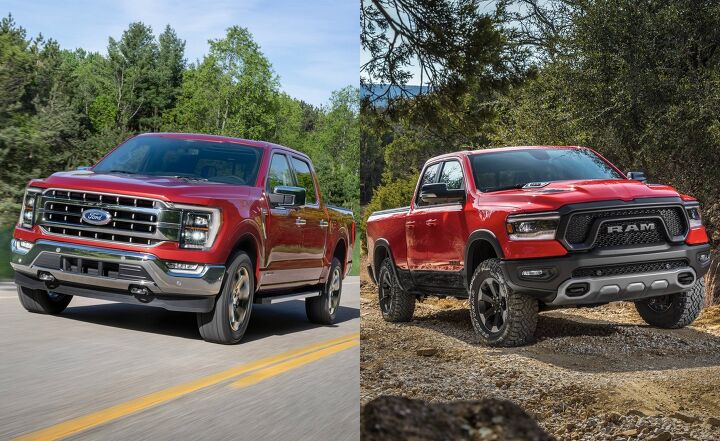






























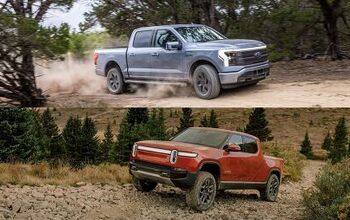
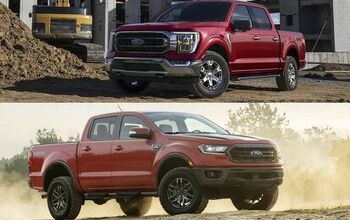

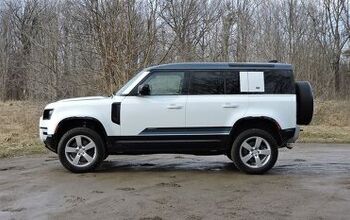


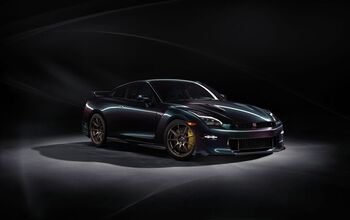
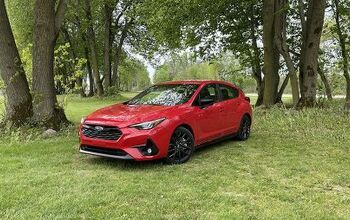


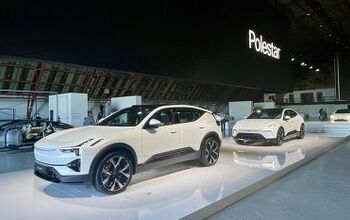




Comments
Join the conversation